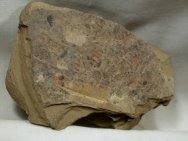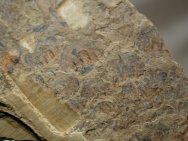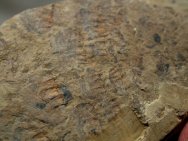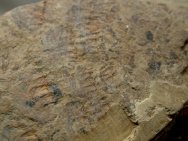| 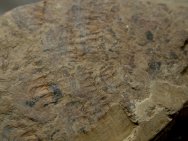 Description:
The discovery of the Chengjiang Biota by Hou Xian-guang in 1984
opened a window onto a remarkable array of lifeforms from what is
termed the Cambrian Explosion. The diversity of soft-tissue fossils
is astonishing: algae, medusiforms, sponges, priapulids, annelid-like
worms, echinoderms, arthropods (including trilobites), hemichordates,
chordates, and the first agnathan fish make up just a small fraction
of the total. Numerous problematic forms are known as well, some
of which may have represented failed attempts at diversity that
did not persist to the present day. Description:
The discovery of the Chengjiang Biota by Hou Xian-guang in 1984
opened a window onto a remarkable array of lifeforms from what is
termed the Cambrian Explosion. The diversity of soft-tissue fossils
is astonishing: algae, medusiforms, sponges, priapulids, annelid-like
worms, echinoderms, arthropods (including trilobites), hemichordates,
chordates, and the first agnathan fish make up just a small fraction
of the total. Numerous problematic forms are known as well, some
of which may have represented failed attempts at diversity that
did not persist to the present day.
This
is a section of the oral disc of the “Terror Of The Cambrian”,
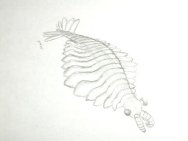 Anomalocaris
saron, seen here in exceptional detail. The members of this group
of enigmatic creatures are known from Asia, Australia, Europe, and
North America, and are thought by many to be closely allied with
the Arthropda, as position not held by all researchers. As of the
publication of Hou’s book in 2004, some 20 examples were known,
most being grasping arms. The spiniferous grasping appendages are
strongly suggestive of its carnivorous habits; some trilobites from
Utah bear evidence of bite marks that have been attributed to Anaomalocaris.
Known only from the Chengjiang biota, this species is closely related
to A. canadensis, the type species, from the younger Burgess Shale.
The genus derives its name from “anomalous shrimp” which
was what the describer thought the appendage was. This fossil however,
is less commonly seen. Imagine you were a small arthropod traveling
near the sea bottom. Suddenly, the sunlight is blotted out by an
immense shadow. This item would be the last thing you saw before
being eaten alive: the oral disc of Anomalocaris. When the analogous
feature was found in the younger Burgess Shale, it was thought to
be a medusoid, and called Peytoia. It consisted of some 2 dozen
sections, and looked much like a pineapple slice. Notice the teeth
present in the center of the picture (an angry pineapple, indeed!). Anomalocaris
saron, seen here in exceptional detail. The members of this group
of enigmatic creatures are known from Asia, Australia, Europe, and
North America, and are thought by many to be closely allied with
the Arthropda, as position not held by all researchers. As of the
publication of Hou’s book in 2004, some 20 examples were known,
most being grasping arms. The spiniferous grasping appendages are
strongly suggestive of its carnivorous habits; some trilobites from
Utah bear evidence of bite marks that have been attributed to Anaomalocaris.
Known only from the Chengjiang biota, this species is closely related
to A. canadensis, the type species, from the younger Burgess Shale.
The genus derives its name from “anomalous shrimp” which
was what the describer thought the appendage was. This fossil however,
is less commonly seen. Imagine you were a small arthropod traveling
near the sea bottom. Suddenly, the sunlight is blotted out by an
immense shadow. This item would be the last thing you saw before
being eaten alive: the oral disc of Anomalocaris. When the analogous
feature was found in the younger Burgess Shale, it was thought to
be a medusoid, and called Peytoia. It consisted of some 2 dozen
sections, and looked much like a pineapple slice. Notice the teeth
present in the center of the picture (an angry pineapple, indeed!).
Also
see: Chengjiang
Biota Fauna List Chengjiang
Fossils
|


